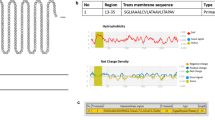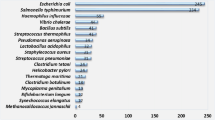Abstract
A hypothetical protein (HP) is one that is known to exist only on the basis of a corresponding gene but without any function assigned to it. Many HPs have emerged as attractive vaccine candidates against prokaryotic and eukaryotic pathogens as well as against cancers. Mycobacterium bovis is a serious veterinary pathogen of tremendous zoonotic importance. This protocol describes a computational workflow for the identification of the HPs of M. bovis with vaccine potential and their subsequent structural and functional characterization.
Access this chapter
Tax calculation will be finalised at checkout
Purchases are for personal use only
Similar content being viewed by others
References
Zarembinski TI, Hung LW, Mueller-Dieckmann HJ, Kim KK, Yokota H, Kim R, Kim SH (1998) Structure based assignment of the biochemical function of a hypothetical protein: a test case of structural genomics. Proc Natl Acad Sci U S A 95(26):15189–15193
Chen C, Chen D, Sharma J, Cheng W, Zhong Y, Liu K, Jensen J, Shain R, Arulanandam B, Zhong G (2006) The hypothetical protein CT813 is localized in the Chlamydia trachomatis inclusion membrane and is immunogenic in women urogenitally infected with C. trachomatis. Infect Immun 74(8):4826–4840
Bashir N, Kounsar F, Mukhopadhyay S, Hasnain SE (2010) Mycobacterium tuberculosis conserved hypothetical protein rRv2626c modulates macrophage effector functions. Immunology 130(1):34–45
Luo T, Patel JG, Zhang X, Walker DH, McBride JW (2020) Ehrlichia chaffeensis and E. canis hypothetical protein immunoanalysis reveals small secreted immunodominant proteins and conformation-dependent antibody epitopes. NPJ Vaccines 5(1):1–2
Zhai Q, Huang B, Dong H, Zhao Q, Zhu S, Liang S, Li S, Yang S, Han H (2016) Molecular characterization and immune protection of a new conserved hypothetical protein of Eimeria tenella. PLoS One 11(6):e0157678
Afjehi-Sadat L, Shin JH, Felizardo M, Lee K, Slavc I, Lubec G (2005) Detection of hypothetical proteins in 10 individual human tumor cell lines. Biochim Biophys Acta 1747(1):67–80
O’Reilly LM, Daborn CJ (1995) The epidemiology of Mycobacterium bovis infections in animals and man: a review. Tuber Lung Dis 76:1–46
Michel AL, Müller B, Van Helden PD (2010) Mycobacterium bovis at the animal–human interface: a problem, or not? Vet Microbiol 140(3):371–381
Cosivi O, Grange JM, Daborn CJ, Raviglione MC, Fujikura T, Cousins D, Robinson RA, Huchzermeyer HF, De Kantor I, Meslin FX (1998) Zoonotic tuberculosis due to Mycobacterium bovis in develo** countries. Emerg Infect Dis 4(1):59
UniProt Consortium (2008) The universal protein resource (UniProt). Nucleic Acids Res 36(Suppl 1):D190–D195
Huang Y, Niu B, Gao Y, Fu L, Li W (2010) CD-HIT suite: a web server for clustering and comparing biological sequences. Bioinformatics 26(5):680–682
Doytchinova IA, Flower DR (2007) VaxiJen: a server for prediction of protective antigens, tumour antigens and subunit vaccines. BMC Bioinformatics 8(1):4
Zhang Y (2008) I-TASSER server for protein 3D structure prediction. BMC Bioinformatics 9(1):40
Gibrat JF, Madej T, Bryant SH (1996) Surprising similarities in structure comparison. Curr Opin Struct Biol 6(3):377–385
Acknowledgments
The author acknowledges the financial support received from M/s Ayurvet Limited, India, during the preparation of this manuscript. The authors of all the computational servers used in the present study are gratefully acknowledged for making their tools available freely and publicly.
Author information
Authors and Affiliations
Editor information
Editors and Affiliations
Rights and permissions
Copyright information
© 2022 The Author(s), under exclusive license to Springer Science+Business Media, LLC, part of Springer Nature
About this protocol
Cite this protocol
Ganguly, B. (2022). Computational Mining and Characterization of Hypothetical Proteins of Mycobacterium bovis Toward the Identification of Probable Vaccine Candidates. In: Thomas, S. (eds) Vaccine Design. Methods in Molecular Biology, vol 2412. Humana, New York, NY. https://doi.org/10.1007/978-1-0716-1892-9_24
Download citation
DOI: https://doi.org/10.1007/978-1-0716-1892-9_24
Published:
Publisher Name: Humana, New York, NY
Print ISBN: 978-1-0716-1891-2
Online ISBN: 978-1-0716-1892-9
eBook Packages: Springer Protocols




